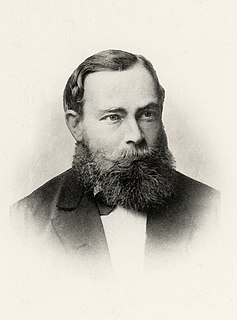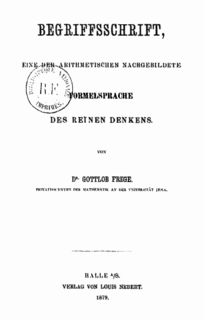First-order logic—also known as predicate logic, quantificational logic, and first-order predicate calculus—is a collection of formal systems used in mathematics, philosophy, linguistics, and computer science. First-order logic uses quantified variables over non-logical objects, and allows the use of sentences that contain variables, so that rather than propositions such as "Socrates is a man", one can have expressions in the form "there exists x such that x is Socrates and x is a man", where "there exists" is a quantifier, while x is a variable. This distinguishes it from propositional logic, which does not use quantifiers or relations; in this sense, propositional logic is the foundation of first-order logic.

The proof of Gödel's completeness theorem given by Kurt Gödel in his doctoral dissertation of 1929 is not easy to read today; it uses concepts and formalisms that are no longer used and terminology that is often obscure. The version given below attempts to represent all the steps in the proof and all the important ideas faithfully, while restating the proof in the modern language of mathematical logic. This outline should not be considered a rigorous proof of the theorem.
In mathematical logic, the Peano axioms, also known as the Dedekind–Peano axioms or the Peano postulates, are axioms for the natural numbers presented by the 19th century Italian mathematician Giuseppe Peano. These axioms have been used nearly unchanged in a number of metamathematical investigations, including research into fundamental questions of whether number theory is consistent and complete.
The relational model (RM) is an approach to managing data using a structure and language consistent with first-order predicate logic, first described in 1969 by English computer scientist Edgar F. Codd, where all data is represented in terms of tuples, grouped into relations. A database organized in terms of the relational model is a relational database.

In mathematical logic, Russell's paradox is a set-theoretic paradox discovered by the British philosopher and mathematician Bertrand Russell in 1901. Russell's paradox shows that every set theory that contains an unrestricted comprehension principle leads to contradictions. The paradox had already been discovered independently in 1899 by the German mathematician Ernst Zermelo. However, Zermelo did not publish the idea, which remained known only to David Hilbert, Edmund Husserl, and other academics at the University of Göttingen. At the end of the 1890s, Georg Cantor – considered the founder of modern set theory – had already realized that his theory would lead to a contradiction, which he told Hilbert and Richard Dedekind by letter.

Friedrich Ludwig Gottlob Frege was a German philosopher, logician, and mathematician. He worked as a mathematics professor at the University of Jena, and is understood by many to be the father of analytic philosophy, concentrating on the philosophy of language, logic, and mathematics. Though he was largely ignored during his lifetime, Giuseppe Peano (1858–1932), Bertrand Russell (1872–1970), and, to some extent, Ludwig Wittgenstein (1889–1951) introduced his work to later generations of philosophers. Frege is widely considered to be the greatest logician since Aristotle, and one of the most profound philosophers of mathematics ever.
In mathematical logic, a universal quantification is a type of quantifier, a logical constant which is interpreted as "given any" or "for all". It expresses that a predicate can be satisfied by every member of a domain of discourse. In other words, it is the predication of a property or relation to every member of the domain. It asserts that a predicate within the scope of a universal quantifier is true of every value of a predicate variable.
In set theory, Zermelo–Fraenkel set theory, named after mathematicians Ernst Zermelo and Abraham Fraenkel, is an axiomatic system that was proposed in the early twentieth century in order to formulate a theory of sets free of paradoxes such as Russell's paradox. Today, Zermelo–Fraenkel set theory, with the historically controversial axiom of choice (AC) included, is the standard form of axiomatic set theory and as such is the most common foundation of mathematics. Zermelo–Fraenkel set theory with the axiom of choice included is abbreviated ZFC, where C stands for "choice", and ZF refers to the axioms of Zermelo–Fraenkel set theory with the axiom of choice excluded.
Relevance logic, also called relevant logic, is a kind of non-classical logic requiring the antecedent and consequent of implications to be relevantly related. They may be viewed as a family of substructural or modal logics. It is generally, but not universally, called relevant logic by British and, especially, Australian logicians, and relevance logic by American logicians.
A formula of the predicate calculus is in prenex normal form (PNF) if it is rewritten as a string of quantifiers and bound variables, called the prefix, followed by a quantifier-free part, called the matrix. Together with the normal forms in propositional logic, it provides a canonical normal form useful in automated theorem proving.
In formal semantics and philosophy of language, a definite description is a denoting phrase in the form of "the X" where X is a noun-phrase or a singular common noun. The definite description is proper if X applies to a unique individual or object. For example: "the first person in space" and "the 42nd President of the United States of America", are proper. The definite descriptions "the person in space" and "the Senator from Ohio" are improper because the noun phrase X applies to more than one thing, and the definite descriptions "the first man on Mars" and "the Senator from some Country" are improper because X applies to nothing. Improper descriptions raise some difficult questions about the law of excluded middle, denotation, modality, and mental content.
In model theory, a transfer principle states that all statements of some language that are true for some structure are true for another structure. One of the first examples was the Lefschetz principle, which states that any sentence in the first-order language of fields that is true for the complex numbers is also true for any algebraically closed field of characteristic 0.

Begriffsschrift is a book on logic by Gottlob Frege, published in 1879, and the formal system set out in that book.
In philosophical logic, the masked-man fallacy is committed when one makes an illicit use of Leibniz's law in an argument. Leibniz's law states that if A and B are the same object, then A and B are indiscernible. By modus tollens, this means that if one object has a certain property, while another object does not have the same property, the two objects cannot be identical. The fallacy is "epistemic" because it posits an immediate identity between a subject's knowledge of an object with the object itself, failing to recognize that Leibniz's Law is not capable of accounting for intensional contexts.
In logic, the monadic predicate calculus is the fragment of first-order logic in which all relation symbols in the signature are monadic, and there are no function symbols. All atomic formulas are thus of the form , where is a relation symbol and is a variable.

The Foundations of Arithmetic is a book by Gottlob Frege, published in 1884, which investigates the philosophical foundations of arithmetic. Frege refutes other theories of number and develops his own theory of numbers. The Grundlagen also helped to motivate Frege's later works in logicism. The book was not well received and was not read widely when it was published. It did, however, draw the attentions of Bertrand Russell and Ludwig Wittgenstein, who were both heavily influenced by Frege's philosophy. An English translation was published by J. L. Austin, with a second edition in 1960.
In mathematical logic, the ancestral relation of a binary relation R is its transitive closure, however defined in a different way, see below.
The Frege–Church ontology is an ontology, a theory of existence. Everything is considered as being in three categories, object, name, or concept (sense). The ontology was developed by Alonzo Church based on ideas of Gottlob Frege to resolve some paradoxes. The ontology is related to certain modal logics.
In logic, a quantifier is an operator that specifies how many individuals in the domain of discourse satisfy an open formula. For instance, the universal quantifier in the first order formula expresses that everything in the domain satisfies the property denoted by . On the other hand, the existential quantifier in the formula expresses that there exists something in the domain which satisfies that property. A formula where a quantifier takes widest scope is called a quantified formula. A quantified formula must contain a bound variable and a subformula specifying a property of the referent of that variable.









